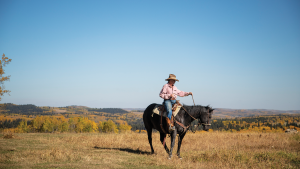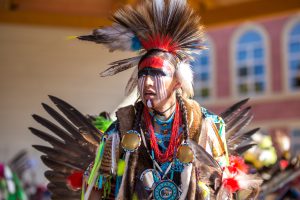The men’s dressing room below the grandstand at the Calgary Stampede feels a little like a hospital waiting room, but not as clean. It’s a Thursday afternoon in July, toward the end of the 10-day rodeo competition, and cowboys wrapped in elastic bandages and ice packs are splayed out on a set of couches, grinding mud into the fabric and trading stories. Strewn across the carpet is a mess of well scuffed boots, spurs and chaps, frayed reins, blue jeans in various states of disrepair: the telltale detritus of a rodeo.
On one couch, Tyler Thomson, in a bright purple button-up shirt with Wrangler written across the back, is running through his hit-list for me: “Plenty of bumps, bruises, stitches, a broken thumb. But my knees, I guess you could say, have been my Kryptonite.” Thomson, 31 years old and from one of the most storied families of Calgary rodeo, has blue eyes, a million-dollar smile and one Canadian Professional Rodeo Association championship under his belt. “I think I’ve torn every ligament out of my right knee,” he says, “and I tore the ACL out of my left knee. Kept me out a year and a half. But nothing too serious, knock on wood.” In an hour or so, for the third day in a row, Thomson will mount a nearly one-tonne bull and try to stay on for eight seconds.
The Calgary Stampede — Alberta’s yearly paean to cowboy culture, equal parts rodeo and country fair — had its humble beginnings in 1912 as the Frontier Days and Cowboy Championship contest. Its founder, Guy Weadick, was both working cowboy and Vaudeville showman. The seminal Stampede featured a parade of 2,000 “Indians” in full dress, a rodeo with a $16,000 jackpot (won by bronc rider Tom Three Persons of the Blood First Nation) and bands of roving cowboys on horseback who would lasso pretty girls on Centre Street. The curious mix of choreographed spectacle and raw athletic competition, with real cowboys risking life and limb for a shot at prize money, proved a crowd pleaser. In the intervening century, that formula has changed little.
I leave Thomson to meditate on the day’s bull and plunge into the controlled chaos of Stampede Park. On a good day, upwards of 100,000 people pack the sprawling grounds: 193 acres of carnival rides, deep-fried Oreos, whackable moles, barnyard demos, tipi villages, a country music stage and beer gardens. Heat and crowds and the blink of a million little coloured light bulbs trigger my carnival instincts. I gorge on something called a doughnut burger. I almost win a gorilla-sized stuffed gorilla at ring toss. On the midway, I brave the Orbiter, the Crazy Mouse and the fearsome Mega Drop. And I breathe in that heady carnival perfume: cotton candy, frying sausages and barnyard smells.
On the very edge of the maelstrom, I find Dave “The Bullet” Smith Jr., poking his head into the business end of a 10.5-metre-long cannon. He asks me not to take any photos. “How the cannons work is kind of our family secret,” he says. “But I’ll tell you what: this gun here will sure get you moving.”
In a few minutes, Smith will don what looks like a black bicycle helmet and be fired 45 metres across the midway into a small net, enduring, he says, “10 G” of force on lift-off, or roughly triple anything experienced by a space shuttle astronaut. I stick around to watch the firing. Smith stays in the air for an ungodly long time — long enough to use his arm as a kind of airborne rudder, which guides him safely across the ether and into the waiting net.
After the human cannonball bows to the crowd, I make for the exit. The party which is Stampede long ago jumped Stampede Park and now consumes much of Calgary’s downtown. Not far from the gates, Buzzards Restaurant & Bar, like many Calgary watering holes, has erected a wooden fence around its perimeter and put out bales of hay.
On the sunny patio under a large awning, a group from a local construction company has assembled for a buffet dinner. They’re decked out in straw hats and moustaches grown expressly for the occasion. Busy serving shaved sirloin at the buffet table is Buzzards’ Cory Hanline, a mountain of a man who is clearly in Stampede spirit. He slaps a pair of metal tongs against the grill to the beat of the Rolling Stones’ “Honky Tonk Woman,” played by a cover band on the tiny patio stage. “Without a doubt, best party of the year,” Hanline says, unloading a spoon of baked beans onto a plate. “It’s like Christmas — as soon as it’s over, we all start counting the days until the next one.”
Two blocks north along Stephen Avenue, an upscale pedestrian drag, an haute-Stampede air prevails. Street buskers play jazz standards and patios of tony restaurants overflow with patrons. I find a seat inside Divino Wine & Cheese Bistro, which has exposed brick walls, a stylishly scuffed wood floor and a 31-page wine list. My Alberta rib steak ($37) comes with truffled pomme puree, not cheese fries. And, for tonight at least, I trade my Stampede-issue Bud for a glass of Argentine malbec.
After dinner, I follow a trickle of Stampeders to a nearby concert in Calgary’s Olympic Plaza. Medals were handed out here during the 1988 Winter Games, whose success augured the city’s morph from cowtown to modern city. Tonight, I’m surprised to find a group of mop-topped teens on stage playing angst-ridden rock, with nary a hint of country twang. Watching at a safe distance is Bob Slocombe, volunteer chair of Calgary’s Downtown Attractions Committee. I find out he’s an ambassador of sorts, charged with winning over Stampede holdouts and skeptics.
“We’re reaching out to a new demographic tonight,” says Slocombe, who looks like a cowboy Santa Claus. In the morning, Slocombe also proffers free pancake breakfasts, buggy rides and shoot-‘em-up Wild West shows, all to woo newcomers. (Tomorrow, in fact, I’ll be treated to the surreal sight of a woman in a hijab posing here for a photo with a troupe of grizzled old-timey gunfighters, while her two little sons paw antique revolvers.)
At the heart of the Stampede, as pure and incorruptible as it is controversial, remains the rodeo. For 10 straight days, competitors face off each afternoon in a series of primal, brutal and, in their way, beautiful contests. Bull riders mount the backs of car-sized mounds of muscle. Steer wrestlers fling themselves off sprinting horses and onto the horns of angry animals. Bareback riders are launched like dolls from bucking broncos, landing face down in the dirt. While the ethics of rodeo may be a source of debate, the mettle of its riders isn’t. Injuries are common and a culture of genuine, reckless bravado prevails, which makes hockey look almost effete by comparison.
“Your career is just from one ride to the next,” says Mike Duncan, a one-time bull rider from Texas whose 24-year-old son, Douglas, is competing in the Stampede with broken ribs after being hooked and stomped by a bull in his last event. “It can end at any minute, at any time.”
It’s Wildcard Saturday now, the eve of the big Sunday finale, and Tyler Thomson, still in his purple Wrangler shirt, is about to get back on a bull called White Knight. The buzz in the stands attenuates as he climbs the metal rails of the bucking chute and slips his legs around the animal’s enormous back. In the relative silence, you can hear the ominous clang of horn and hoof on steel as the bull rears and bucks in the tight confines of the chute. Thomson wraps his hand into the bull rope, grips hard and takes a breath. Then he nods.
The gate flings out and the bull launches a foot or more off the ground in an apoplexy of rage and fear, its eyes wild and foam jetting from its mouth. Back legs rocket up and the animal’s back bends so far it looks like it will snap. Then the bull plunges into a frantic spin — around and around and around, launching clods of mud across the infield while its muscled neck whips side to side. Each buck convulses Thomson’s body, sending a shudder rippling through his frame. Then the horn blows — his eight seconds are up — and Thomson is diving head first for the dirt. Now he’s on his feet, brushing off, raising both arms. Somewhere underneath his helmet and mask, he’s smiling.
A half-hour later, Thomson is seated at a folding table with the other riders, signing autographs with a Sharpie. The long lines — of teen girls in braces and cut-off shorts, little kids and bashful old cowboys — are mainly for him. In the hot sun, he signs programs, cowboy hats and even big stuffed gorillas. Tomorrow, Thomson will be back on a bull, this time riding for the championship and $100,000 prize. “It’s been a long time since a Thomson won a Stampede,” he says. “I wanna be in them record books, with my name in there next to my grandfather’s and great uncle’s and stuff.”




